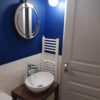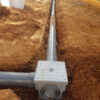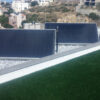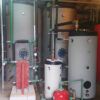The main part of a solar water heater is the solar panels (or mirrors), which are the collection surface of the solar radiation. It consists of four parts:
The radiation collection plate
The water flow pipes
The cover (crystal) of the absorption plate and
The thermally insulated frame on which the other components are attached.
Operation of solar panels
The operation of the collectors of the solar water heater is based on the greenhouse effect that develops in the space between the absorption plate and the glass coating. First, the sun’s rays fall on the (usually black) absorbent plate, raising its temperature. The plate in turn emits long-wavelength radiation (thermal radiation) for which the glass covering the plate is almost opaque. Thus the long-wavelength radiation (heat) is trapped between the plate and the glass, thus increasing the efficiency in terms of water heating (circulating in pipes that are in contact with the plate at the back or integrated in ‘ she).
The critical factors for the good performance of the system are the high absorbency of the plate in the solar radiation, the small emission factor of the plate in the long wave radiation and the high opacity of the crystal for the second. The materials that offer the best value for money are glass and titanium coated aluminum or copper. (selective)
The solar water heater as an ecological device
The solar water heater is one of the “cleanest” and most efficient devices that use renewable energy sources. During its life, the solar water heater usually saves 2 thousand euros from the electricity bills at 2005 prices, while avoiding the release of 30 tons of carbon dioxide into the atmosphere. Every shower with water from a solar water heater is equivalent to 3 kilos of carbon dioxide less in the Earth’s atmosphere.
History
The solar water heater began to be used after the oil crisis of 1973 and especially in the 1980s began to be widely used in sunny countries. In Cyprus there is one solar water heater for every five inhabitants, while in Israel their use is mandatory in new buildings. In many other countries their use is subsidized.
In Greece the spread of solar devices is very impressive: the first model was launched on the market in 1974, while in 1980 there were around 150 thousand square meters of collectors and in 2004 they reached 3 million square meters of collectors. Part of the success of this solar water heater in Greece is due to the tax incentives established by the Greek state. Today, solar water heaters are used by more than one million consumers. Until recent years, Greece was one of the main manufacturers of solar water heaters.
The solar water heater is an active solar thermal system for the production of domestic hot water using solar energy.
It is widely used in countries that have a lot of sunshine, such as in the Mediterranean countries.
The solar water heater is the simplest and most well-known solar device. During its operation, two natural phenomena are exploited. With the beginning of the water heater, the circulation of water is achieved in a natural way without mechanical parts (pumps, etc.) while the heating of the water is done by exploiting the greenhouse effect that develops in its collectors.
Kinds
We distinguish two types of solar water heaters depending on the circulation circuit of the heated medium:
Open circuit: direct heating of the use water (the heating medium is the water we will use), this device allows fast heating, but in areas with hard water they are constantly clogged.
Closed circuit: indirect heating of the use water (the heating medium circulates in a special circuit which heats the water to be used without mixing them, through a heat exchanger), this device delays the heating of the water but does not clog easily even with hard water.
Open circuit solar water heaters are simpler and cheaper, but they have problems at low temperatures (frosts) because we can not add antifreeze to them (the heating medium is the water itself). In closed circuit solar water heaters, the heating medium may be another fluid (eg oil). If it is only water, it has antifreeze and anti-corrosion additives to protect the device.
We can also categorize solar water heaters according to the number of energy sources that can be exploited in:
Dual energy: The water heater operates using either solar energy or electricity (eg during cloudy days when solar energy is not enough to heat water). For this purpose, there is an electrical resistor mounted inside the storage compartment.
Triple energy: It works like a dual energy solar water heater but also has an inlet to take advantage of the hot water of the radiator produced by the central heating boiler as a heating medium. Prerequisite for the installation of a triple energy solar water heater is to have the appropriate infrastructure in the house in the form of separate piping (per apartment if it is an apartment building) that connects the boiler room with the installation of the solar water heater (terrace or roof).
Places
Solar water heaters, regardless of their type, consist of two main parts:
The collection section (solar panels, the surface of absorption of solar radiation)
The storage section (the water storage tank)
These two parts are assembled together and connected by piping, but in larger systems they can be separate and pumps can be used to circulate the heated medium, especially when the storage compartment is not in the same space as the collection compartment. The storage unit also has an electrical resistor with a thermostat, so that hot water can be produced even in bad weather conditions. Solar water heaters also have some control components such as overpressure valve and automatic vents.
Anode
The anode is a magnesium rod [usually Φ22Χ30mm] and is actually the cathodic protection of the system from electrolysis. It is a method of protection against corrosion of metals which come in contact with corrosive materials (water). Cathodic protection is achieved by adding a suitable material, the ANODE, which corrodes in place of the protected metals. The use of the MAGNESIUM anode of German specifications is the most appropriate method of protection of water supply-heating and solar installations both in terms of technology and in terms of hygiene.
Heating
Mode
Columns & vent valve
In the engine room, with a burner & boiler, water coming from a tank is heated & then it is piped to the radiators. The hot water is supplied to the body by one pipe & expels the cold from the other, which ends up in the tank. Because all metals are very heat friendly, the body heats up almost immediately and transmits heat to the space. However, over time, the water evaporates even slightly, which reduces the efficiency. Therefore, before starting regular operation when the cold winter weather begins, the bodies must be ventilated with a special key that opens the valve & allows air to escape, at the same time filling its space with water from the tank.
As a system, the radiator is divided into 2 categories, “central heating” & “autonomous heating”. In central heating the heating is provided from house to house, from room to room, from apartment to apartment & from floor to floor, thus creating disadvantages (delay & reduction of heating duration) in high-rise apartments. That is why in modern apartment buildings, it has been replaced by the autonomous one, where each apartment has its own boiler & is put into operation by the resident & for as long as he wants.
Oil radiators are heated by electricity & contain oil, due to its ability to retain heat for significantly longer.
Why autonomous heating.
“Non-autonomous” could be characterized as a heating installation (usually of an old apartment building) consisting of a central boiler that supplies hot water to the radiators of all apartments simultaneously, through pipes that run vertically through the building, as in the following figure:
In older installations, heating pipes are common to all building apartments and usually run through the building with more than one central vertical column passing through all properties. Thus, in these buildings, it is not possible to independently regulate the temperature in each apartment, but the apartments are heated all together during the hours of operation of the installation.
This has a negative effect on both the quality of the heating and the operating costs of the installation. In these buildings the uniformity in temperature of each apartment depends on the accuracy and success of the heating study and the overall quality of construction (mainly in terms of insulation) of the building. There are many cases in which many apartments in such buildings overheat during the heating hours and the tenants are forced to open the windows and balcony doors (which means a lot of energy waste), as well as there are many cases of apartments that are not heated enough. (mainly on the top floor of the building).
Ways to measure consumption in central heating systems
The independence of the apartments in a building can be done in three ways:
By timing.
By calorimeter
With wireless autonomy system with thermostatic heads
maintaining the dependence of the apartments on central heating
Ways of autonomy in a central heating installation.png
Ways of autonomy with individual heating system.
The systems that are suitable for the construction of an individual installation are:
Autonomous heating with individual gas unit.
Autonomous heating with individual oil boiler
Autonomous heating with heat pump.
Autonomous heating with electric boiler
Autonomous heating with electric radiators


 ·
· Ελληνικά
Ελληνικά



